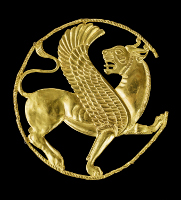Disc-Headed Pin
Large numbers of decorated disc-headed pins were found in the sanctuary at Surkh Dum-i-Luri. They may have been votive offerings to a fertility goddess or, on analogy with a modern ethnographic parallel, deposits verifying wedding contracts among nomadic peoples moving through the area. The decoration of this example, with an eight-petaled central rosette and surrounding borders of smaller rosettes and punctate patterns, is typical. The tiny incised lion's (?) head faces away from the shaft because the pins were worn with the head hanging down and the shaft pointing up.
King Ashurnasirpal II
Room G in Ashurnasirpal II's palace may have served as the setting for a ritual by which weapons were purified. The walls of this chamber were adorned with exceptionally well-carved and minutely detailed reliefs showing the king standing between, alternately, two courtiers and two winged genies. This fragment shows the king himself, identifiable by his fez-shaped cap surmounted by a conical spike. Originally, this piece formed part of a scene. The king, grasping a bow, stood ready to pour a libation from a cup poised delicately on the tips of his fingers. Facing him was an attendant who carried a fly-whisk with which to banish insects from the royal presence.
Persian Roundel
This snarling winged lion worked in gold repoussé attests to the exceptional skill of Achaemenid goldsmiths. The back of the horned feline's body and the slender twisted cord that surrounds it bear sixteen tiny loops for attachment to a garment or textile. Greek writers often speak of the tremendous wealth of the Persians, and Herodotus writes that King Xerxes' troops "were adorned with the greatest magnificence...they glittered all over with gold, vast quantitites of which they wore about their persons" (vii.83).




